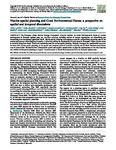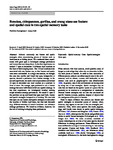Marine spatial planning and Good Environmental Status: a perspective on spatial and temporal dimensions
| dc.contributor.author | Gilbert, AJ | |
| dc.contributor.author | Alexander, K | |
| dc.contributor.author | Sardá, R | |
| dc.contributor.author | Brazinskaite, R | |
| dc.contributor.author | Fischer, C | |
| dc.contributor.author | Gee, K | |
| dc.contributor.author | Jessopp, M | |
| dc.contributor.author | Kershaw, P | |
| dc.contributor.author | Los, HJ | |
| dc.contributor.author | March Morla, D | |
| dc.contributor.author | O'Mahony, C | |
| dc.contributor.author | Pihlajamäki, M | |
| dc.contributor.author | Rees, Sian | |
| dc.contributor.author | Varjopuro, R | |
| dc.date.accessioned | 2018-08-13T13:03:05Z | |
| dc.date.available | 2018-08-13T13:03:05Z | |
| dc.date.issued | 2015 | |
| dc.identifier.issn | 1708-3087 | |
| dc.identifier.issn | 1708-3087 | |
| dc.identifier.other | art64 | |
| dc.identifier.uri | http://hdl.handle.net/10026.1/12050 | |
| dc.description.abstract |
The European Union Marine Strategy Framework Directive requires the Good Environmental Status of marine environments in Europe's regional seas; yet, maritime activities, including sources of marine degradation, are diversifying and intensifying in an increasingly globalized world. Marine spatial planning is emerging as a tool for rationalizing competing uses of the marine environment while guarding its quality. A directive guiding the development of such plans by European Union member states is currently being formulated. There is an undeniable need for marine spatial planning. However, we argue that considerable care must be taken with marine spatial planning, as the spatial and temporal scales of maritime activities and of Good Environmental Status may be mismatched. We identify four principles for careful and explicit consideration to align the requirements of the two directives and enable marine spatial planning to support the achievement of Good Environmental Status in Europe's regional seas. | |
| dc.language | en | |
| dc.language.iso | en | |
| dc.publisher | Resilience Alliance, Inc. | |
| dc.subject | DPSWR | |
| dc.subject | Good Environmental Status | |
| dc.subject | marine spatial planning | |
| dc.subject | maritime spatial planning | |
| dc.subject | spatial scale temporal scale | |
| dc.title | Marine spatial planning and Good Environmental Status: a perspective on spatial and temporal dimensions | |
| dc.type | journal-article | |
| dc.type | Journal Article | |
| plymouth.author-url | https://www.webofscience.com/api/gateway?GWVersion=2&SrcApp=PARTNER_APP&SrcAuth=LinksAMR&KeyUT=WOS:000353293900012&DestLinkType=FullRecord&DestApp=ALL_WOS&UsrCustomerID=11bb513d99f797142bcfeffcc58ea008 | |
| plymouth.issue | 1 | |
| plymouth.volume | 20 | |
| plymouth.publication-status | Published online | |
| plymouth.journal | Ecology and Society | |
| dc.identifier.doi | 10.5751/es-06979-200164 | |
| plymouth.organisational-group | /Plymouth | |
| plymouth.organisational-group | /Plymouth/Faculty of Science and Engineering | |
| plymouth.organisational-group | /Plymouth/Faculty of Science and Engineering/School of Biological and Marine Sciences | |
| plymouth.organisational-group | /Plymouth/REF 2021 Researchers by UoA | |
| plymouth.organisational-group | /Plymouth/REF 2021 Researchers by UoA/UoA14 Geography and Environmental Studies | |
| plymouth.organisational-group | /Plymouth/Users by role | |
| plymouth.organisational-group | /Plymouth/Users by role/Academics | |
| dc.identifier.eissn | 1708-3087 | |
| dc.rights.embargoperiod | Not known | |
| rioxxterms.versionofrecord | 10.5751/es-06979-200164 | |
| rioxxterms.licenseref.uri | http://www.rioxx.net/licenses/all-rights-reserved | |
| rioxxterms.type | Journal Article/Review |



